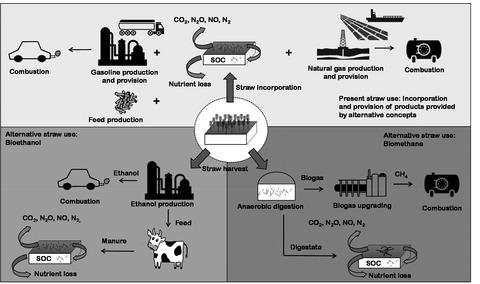当前位置:
X-MOL 学术
›
GCB Bioenergy
›
论文详情
Our official English website, www.x-mol.net, welcomes your
feedback! (Note: you will need to create a separate account there.)
Straw utilization for biofuel production: A consequential assessment of greenhouse gas emissions from bioethanol and biomethane provision with a focus on the time dependency of emissions
Global Change Biology Bioenergy ( IF 5.9 ) Pub Date : 2020-08-20 , DOI: 10.1111/gcbb.12734 Benedikt Buchspies 1, 2 , Martin Kaltschmitt 1 , Martin Junginger 2
Global Change Biology Bioenergy ( IF 5.9 ) Pub Date : 2020-08-20 , DOI: 10.1111/gcbb.12734 Benedikt Buchspies 1, 2 , Martin Kaltschmitt 1 , Martin Junginger 2
Affiliation

|
The shift from straw incorporation to biofuel production entails emissions from production, changes in soil organic carbon (SOC) and through the provision of (co‐)products and entailed displacement effects. This paper analyses changes in greenhouse gas (GHG) emissions arising from the shift from straw incorporation to biomethane and bioethanol production. The biomethane concept comprises comminution, anaerobic digestion and amine washing. It additionally provides an organic fertilizer. Bioethanol production comprises energetic use of lignin, steam explosion, enzymatic hydrolysis and co‐fermentation. Additionally, feed is provided. A detailed consequential GHG balance with in‐depth focus on the time dependency of emissions is conducted: (a) the change in the atmospheric load of emissions arising from the change in the temporal occurrence of emissions comparing two steady states (before the shift and once a new steady state has established); and (b) the annual change in overall emissions over time starting from the shift are assessed. The shift from straw incorporation to biomethane production results in net changes in GHG emissions of (a) −979 (−436 to −1,654) and (b) −955 (−220 to −1,623) kg CO2‐eq. per tdry matter straw converted to biomethane (minimum and maximum). The shift to bioethanol production results in net changes of (a) −409 (−107 to −610) and (b) −361 (57 to −603) kg CO2‐eq. per tdry matter straw converted to bioethanol. If the atmospheric load of emissions arising from different timing of emissions is neglected in case (a), the change in GHG emissions differs by up to 54%. Case (b) reveals carbon payback times of 0 (0–49) and 19 (1–100) years in case of biomethane and bioethanol production, respectively. These results demonstrate that the detailed inclusion of temporal aspects into GHG balances is required to get a comprehensive understanding of changes in GHG emissions induced by the introduction of advanced biofuels from agricultural residues.
中文翻译:

秸秆用于生物燃料生产:对生物乙醇和生物甲烷提供的温室气体排放的结果评估,重点是排放的时间依赖性
从秸秆还田到生物燃料生产的转变包括生产,土壤有机碳(SOC)的变化以及提供(副产品)产生的排放以及置换效应。本文分析了从秸秆掺入向生物甲烷和生物乙醇生产的转变所引起的温室气体(GHG)排放变化。生物甲烷的概念包括粉碎,厌氧消化和胺洗涤。它还提供有机肥料。生物乙醇生产包括大量使用木质素,蒸汽爆炸,酶促水解和共同发酵。此外,提供了提要。进行了详细的结果性温室气体平衡,并深入关注了排放的时间依赖性:(a)比较两个稳态(在转移之前和一旦建立新的稳态时),由排放的时间变化引起的大气排放负荷的变化;(b)评估从这一变化开始的总排放随时间的年度变化。从秸秆掺入到生物甲烷生产的转变导致(a)-979(-436至-1,654)和(b)-955(-220至-1,623)kg COG的温室气体排放净变化2 eq。每吨干物质秸秆转化为生物甲烷(最小和最大)。向生物乙醇生产的转变导致(a)-409(-107至-610)和(b)-361(57至-603)kg CO 2当量净变化。每吨干物质秸秆转化为生物乙醇。如果在情况(a)中忽略了由不同排放时间引起的大气排放负荷,则温室气体排放的变化相差最多54%。案例(b)显示,在生产生物甲烷和生物乙醇的情况下,碳的回收期分别为0(0-49)年和19(1-100)年。这些结果表明,需要详细地将时间方面纳入温室气体平衡中,以全面了解由农业残留物引入高级生物燃料引起的温室气体排放变化。
更新日期:2020-08-20
中文翻译:

秸秆用于生物燃料生产:对生物乙醇和生物甲烷提供的温室气体排放的结果评估,重点是排放的时间依赖性
从秸秆还田到生物燃料生产的转变包括生产,土壤有机碳(SOC)的变化以及提供(副产品)产生的排放以及置换效应。本文分析了从秸秆掺入向生物甲烷和生物乙醇生产的转变所引起的温室气体(GHG)排放变化。生物甲烷的概念包括粉碎,厌氧消化和胺洗涤。它还提供有机肥料。生物乙醇生产包括大量使用木质素,蒸汽爆炸,酶促水解和共同发酵。此外,提供了提要。进行了详细的结果性温室气体平衡,并深入关注了排放的时间依赖性:(a)比较两个稳态(在转移之前和一旦建立新的稳态时),由排放的时间变化引起的大气排放负荷的变化;(b)评估从这一变化开始的总排放随时间的年度变化。从秸秆掺入到生物甲烷生产的转变导致(a)-979(-436至-1,654)和(b)-955(-220至-1,623)kg COG的温室气体排放净变化2 eq。每吨干物质秸秆转化为生物甲烷(最小和最大)。向生物乙醇生产的转变导致(a)-409(-107至-610)和(b)-361(57至-603)kg CO 2当量净变化。每吨干物质秸秆转化为生物乙醇。如果在情况(a)中忽略了由不同排放时间引起的大气排放负荷,则温室气体排放的变化相差最多54%。案例(b)显示,在生产生物甲烷和生物乙醇的情况下,碳的回收期分别为0(0-49)年和19(1-100)年。这些结果表明,需要详细地将时间方面纳入温室气体平衡中,以全面了解由农业残留物引入高级生物燃料引起的温室气体排放变化。











































 京公网安备 11010802027423号
京公网安备 11010802027423号